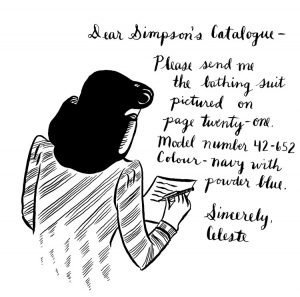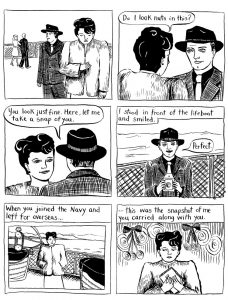By Stacey May Fowles
“If I don’t do something I feel compelled to do, I know I’ll be unhappy and eventually unwell, so I get to work on it, regardless of the challenges.”
—Rebecca Kraatz, March 2011
 In 2007, Rebecca Kraatz’s debut graphic novel House of Sugar won her a prestigious Doug Wright Award for Best Emerging Talent. The media crowned her as one to watch, using words like “quirky” to describe her work. Comic fans were most certainly in love with Sugar’s inventiveness, and the release positioned Kraatz among Canada’s finest autobiographical, confessional indie comic-makers, including heavy-hitters like Julie Doucet and Seth. To say that her next release was eagerly awaited would be an understatement, considering the praise and accolades that accompanied her mesmerizing debut.
In 2007, Rebecca Kraatz’s debut graphic novel House of Sugar won her a prestigious Doug Wright Award for Best Emerging Talent. The media crowned her as one to watch, using words like “quirky” to describe her work. Comic fans were most certainly in love with Sugar’s inventiveness, and the release positioned Kraatz among Canada’s finest autobiographical, confessional indie comic-makers, including heavy-hitters like Julie Doucet and Seth. To say that her next release was eagerly awaited would be an understatement, considering the praise and accolades that accompanied her mesmerizing debut.
Born in British Columbia’s Okanagan Valley, and raised in the Alberta prairies and on Vancouver Island, Kraatz currently calls Nova Scotia home. She is poised to release her second graphic novel, Snaps, at the Toronto Comic Arts Festival this spring — it’s a book she’s been working on for more than three years. On the surface it’s a period piece; at its core it’s a complex, interwoven narrative employing the multiple points of view and stylistic innovations Kraatz’s first book was rightly lauded for.
The book is comprised of characters that Kraatz developed out of a happenstance discovery at a flea market. “One day I was flipping through an old photo album I purchased at a Victoria flea market,” she explains. “It contains black and white photos of people I don’t know, but I’ve looked at the photos often enough to feel as if I know all the players. So Snaps began when I started writing down what I imagined was happening in their lives.”
The book is named both for its literal source and its dreamy, snapshot style narrative, as characters present the details of their lives in a mere few pages apiece. This technique imbues the historical with the surreal, the narrative firmly rooted in a rich literary tradition, with a nod to pulp and a devotion to the same magical realism that Sugar hinged on. With every page of Snaps, Kraatz reveals herself not only to be a talented artist but also a devoted writer. When asked for her influences and inspirations, Kraatz provides an eclectic list of names that includes Emile Zola, Alice Munro, Anton Chekov, Emily Carr, Lynda Barry, Vic Chestnutt and Elvis Presley.
Setting her new book just before, during and after the Second World War in a tiny town on Vancouver Island, Kraatz explains that the past is often a source of inspiration for her work: “I was quite sick as a teenager and I spent a lot of time at home,” she explains. “I watched many old, ‘Golden Era’ movies and I became interested in the actors, the writers, the clothing and the dialogue. When it dawned on me that my grandparents and their siblings had been young once and lived through the 1940s, I began listening to their stories. To learn even more I read history books, sewed clothes from old patterns and scratched through dirt and moss at an old 1940s garbage dump site. Snaps is a culmination of what I’ve learned, but my interest in the 1940s continues to grow.”
According to Kraatz’s packed resume, she’s worked in the ticket booth at a car racetrack, in a candy store, as a newspaper layout artist, as a make-up artist and hair-stylist and a seamstress. Right now, she’s lucky enough to focus on her writing and art, something that she views as a blessing to be careful with. “One of the biggest challenges of being a writer and artist can be spending so much time alone. You have to be comfortable with that, which I am, but at some point it’s important to bounce ideas off my husband.” (That’s award-winning musician Joel Plaskett, who has used Kraatz’s work on some of his album covers, and has spoken in the media about his wife’s ongoing fascination with the past: “For the most part, she doesn’t care too much about what’s being made today,” he’s been quoted as saying.)
 Despite Kraatz’s interest in yesteryear, she does find real inspiration in her daily life. “My strongest inspirations come from people I know. Getting to see and hear about their dedication and passion to their work. Watching how they create something from a basic idea and the willingness to adapt and change the idea as they go along.” This admiration is not limited to artists, musicians and writers; Kraatz names friends who are mechanics, bakers, and hairdressers as people whose “enthusiasm for what they do can be seen in final results.” This appreciation for craft can also be seen in every character in Snaps, each detail given the time and attention Kraatz knows they deserve.
Despite Kraatz’s interest in yesteryear, she does find real inspiration in her daily life. “My strongest inspirations come from people I know. Getting to see and hear about their dedication and passion to their work. Watching how they create something from a basic idea and the willingness to adapt and change the idea as they go along.” This admiration is not limited to artists, musicians and writers; Kraatz names friends who are mechanics, bakers, and hairdressers as people whose “enthusiasm for what they do can be seen in final results.” This appreciation for craft can also be seen in every character in Snaps, each detail given the time and attention Kraatz knows they deserve.
Opinions have surfaced that Kraatz’s success marks a much-needed shift in the genre towards female readers. But Kraatz doesn’t see herself as a “graphic novelist for women.” “Personally, I don’t face any challenges being a female graphic novelist,” she says. “I don’t have just women or just men in mind when I write and I don’t get too hung up on gender issues.”
As indie comic fans brace themselves for Kraatz’s return, she remains level-headed about the balance between potential fame and everyday creativity. “I try not to set myself up for expectations of ‘success,’” she says. “Sometimes I have to remind myself how lucky I am to be doing what I do, living where I live in a safe place that allows me to be creative on a daily basis.”
images from Snaps, by Rebecca Kraatz
Published by Conundrum Press
